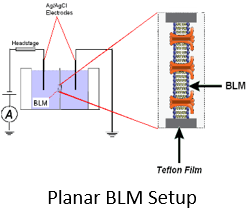Investigating Wild-Type and Mutated LYS in a 2D Model for Use in Drug Delivery
Student: Jess Ray
Degree: M.S., May 2020
Major Professor: Dr. Radwan Al Faouri
Research Area(s):
Nanoscience & Engineering
Background/Relevance
-
Wild type lysenin channels were investigated under the influence of different multivalent ions.
-
Pore-forming toxins (PFTs) inserted into liposomes could create new opportunities for drug delivery systems.
Innovation
- Use the mutated PFTs in experiments to determine the voltage at which they gate and compare it to wild type PFTs.
- Control the drug release out of the lysenin-liposome drug carriers to enhance drug delivery applications.
Approach
- Use Teflon chambers to create a bilayer lipid membrane (BLM) model.
- Prepare lipid solution containing cholesterol, sphingomyelin, and asolectin to create a model cell like animal cell membranes.
- Insert PFT in the BLM to experimentally determine gating voltages (using Axo-Patch).
- Introduce multivalent ions to observe the ligand – induced gating.

Key Results
- Wild type lysenin channels gates at roughly 20mV, while the mutated gated at roughly 30-35mV (as the figure on the left shows).
- Iron divalent cations inhibit the macroscopic current of both wild and mutated lysenin channels at low monovalent ions concentration (as the figure on the right shows).

Conclusions
- Mutated type lysenin gated at a higher voltage than the wild type lysenin did, due to the mutation. This led to roughly a 10-15 mV higher voltage required to cause gating in the mutated type.
- The charge of the mutated lysenin was reduced due to mutation. This led to a higher concentration of iron divalent ions being needed for ligand-induced gating, as hypothesized.
Future Work
- Repeat all experiments with the mutated lysenin.
- Investigate the effects pH has on gating.
